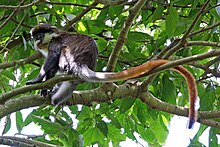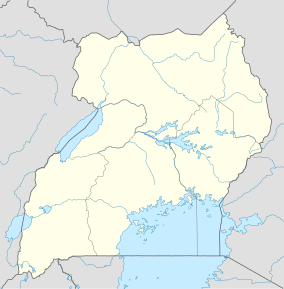Semliki Wildlife Reserve
| Semliki Wildlife Reserve | |
|---|---|
| Toro-Semliki Wildlife Reserve | |
 | |
| Location | Kabarole and Ntoroko districts |
| Nearest city | Fort Portal |
| Coordinates | 00°53′50″N 30°21′48″E / 0.89722°N 30.36333°E |
| Area | 542 km2 (209 sq mi) |
| Established | 1929 |
| Governing body | Uganda Wildlife Authority |
The Semliki Wildlife Reserve is a conservation protected area in the Western Region of Uganda with headquarters at Karugutu in Ntoroko District.[1]It is the oldest wildlife reserve.[2]
Geography
[edit]
Semliki Wildlife Reserve is located in Kabarole and Ntoroko districts, in the Toro sub-region, on the floor of the rift valley, where Lake Albert, the Rwenzori Mountains and the Kijura escarpment create backdrops.[3] The reserve is about 55 km (34 mi), by road, north of Fort Portal, the nearest large city.[4]
History
[edit]First established in 1926 by the British colonial Government, the reserve is one of the oldest protected areas in Uganda extending from the Kijura escarpment, north to the River Muzizi and Lake Albert to the low Butuku plains in the West.[5] Since 2005, the area is considered a Lion Conservation Unit.[6]
Flora and fauna
[edit]The dominant vegetation in Semliki is open Acacia-Combretum woodland and grassy savanna, interspersed with patches of Borassus palm forest. There is significant belts of riparian woodland along the main watercourses, and extensive swamps towards Lake Albert.
Wildlife has partially recovered from the poaching that took a heavy toll during the civil war. The Ugandan kob (Kobus kob) population, which plummeted below 1,000 in the early 1990s, today totals several thousand. More than 1,000 African buffalo are resident, up from about 50 in the early 1990s and elephant and waterbuck numbers are growing too. Leopards are still common, while lions at one point poached to local extinction, are gradually re-colonizing the area. Primates are well represented with black-and-white colobus, olive baboon and red-tailed and vervet monkey all visible in suitable habitats, while a community of perhaps 70 chimpanzees is resident in Mugiri River Forest. The reserve is highly alluring to birdwatchers: some 462 species have been recorded and it is one of the best places in Uganda to see the shoebill.[7]
References
[edit]- ^ Kevin D. Hunt (18 January 2016). "The Toro-Semliki Wildlife Reserve". Bloomington, Indiana, United States: Indiana University: Semliki Chimpanzee Project. Retrieved 7 May 2019.
- ^ "Semuliki National park". Gorilla Trekking Uganda. Retrieved 22 June 2024.
- ^ Uganda Maps. Map of Uganda's National Parks. Uganda: Uganda Maps. p. 6.
- ^ Kamukama, E. (1 January 2019). "Toro Semliki reserve: An adventure in the shadow". Daily Monitor. Retrieved 7 May 2019.
- ^ Uganda Wildlife Authority (2019). "Toro-Semliki Wildlife Reserve". Kampala: Uganda Wildlife Authority. Retrieved 7 May 2019.
- ^ IUCN Cat Specialist Group (2006). Conservation Strategy for the Lion Panthera leo in Eastern and Southern Africa. Pretoria, South Africa: IUCN.
- ^ Briggs, Philip (2016). Uganda: The Bradt Travel Guide. England: Bradt Travel Guides Ltd. pp. 409–410. ISBN 9781784770228.
External links
[edit]


